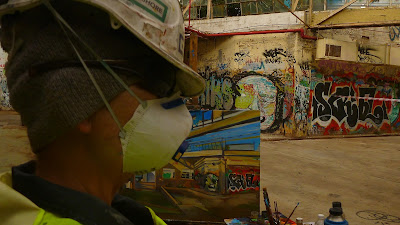In early April 2015 I was asked to paint some of the last manual port movements at the Patrick terminal in Port Botany.
Now the containers are still being unloaded by port workers, but automated straddle cranes stack the containers onto trucks, replacing many port workers.
I was permitted to paint and set up my easel a week before the April change-over.
 | |
| Painting a panorama of Port Botany 31 x 153cm oil on canvas 2015 Enquiries |
My viewpoint was from a narrow balcony above a 2 storey gatehouse.
On the ground floor was the First Aid room, while on the top floor, port workers facing redundancy were receiving career advice.
 |
| Painting a panorama of Port Botany 31 x 153cm oil on canvas 2015 Enquiries |
From my vantage point I could see the yard being prepared for the new automated system.
 |
| Painting a panorama of Port Botany 31 x 153cm oil on canvas 2015 Enquiries |
In the centre, concrete barriers were arranged in grids to separate the trucks from the construction.
To the right, the giant stacks of containers were removed, leaving an eerily empty yard.
 |
| Painting a panorama of Port Botany 31 x 153cm oil on canvas 2015 Enquiries |
 |
| Painting a panorama of Port Botany 31 x 153cm oil on canvas 2015 Enquiries |
At night it looked desolate and lonely.
As the new driverless vehicles are remotely controlled, there won't be the same requirement for lighting the yard.
 |
| Painting the giant straddle cranes Port Botany 75 x 100cm oil on canvas 2015 Enquiries |
 |
| Painting the giant straddle cranes Port Botany 75 x 100cm oil on canvas 2015 Enquiries |
 |
| Paintings of Port Botany Left to right: the giant straddle cranes Port Botany 75 x 100cm oil on canvas 2015 giant straddle cranes Port Botany 100 x 75cm oil on canvas 2015 Night panorama straddle cranes Port Botany 31 x 153cm oil on canvas 2015 Port Botany panorama 31 x 153cm oil on canvas 2015 Enquiries I know that it's all in the name of efficiency, but when I left, it looked like a ghost town. |
 |
| Night,containers, Port Botany 25 x 31cm oil on canvas 2015 Night, Port Botany panorama 20 x 40cm oil on canvas 2015 Enquiries As
the last ship before the changeover was unloaded, a line formed of the
old straddle cranes which were due to be scrapped soon after. |

Night,containers, Port Botany
25 x 31cm oil on canvas 2015
Enquiries
Ominously, while I was painting in my temporary gatehouse studio, I had met some of the same people both delivering and receiving career advice 7 years earlier when the East Darling Harbour Wharves closed down to become Barangaroo.

PB2 'Anatoma, Port Botany' 2015 oil on canvas 28 x 36cm
Enquiries
A few weeks after my stint as 'Artist in Residence' at Port Botany, some of the port workers who had received redundancy, were called back to work when some of the robots malfunctioned and dropped a few containers in the water!
Related Posts






















.JPG)


